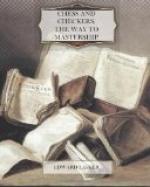(5)
Bxf6 Pxf6
(6)
Rxd7, etc.
Instead of playing (1) P-d4 and taking advantage of the fact that the Pawn e5 is pinned, White can direct his attack against the other Black man which is pinned, namely the Knight f6. He can play (1) Kt-d5 and thereby attack the Queen and at the same time the Knight f6 for the second time. It will not be evident to the beginner that White can derive any advantage from this double attack, as Black can answer either Q-d6 or Q-d8 keeping his Knight twice protected. Indeed, White does not gain anything on f6, the square itself upon which the pin is effected, but he uses the pin to force an opening into the chain of Pawns which protects Black’s King by exchanging on f6, compelling Black to retake with the Pawn g7. The advantage resulting from this break in Black’s Pawn position will be explained later on when discussing the strategy of the middle-game.
SACRIFICING
A player is said to sacrifice if he allows a certain amount of his forces to be captured without recapturing himself an equivalent amount of his opponent’s forces. He will not, of course, knowingly do so unless he expects to obtain some other advantage which will at least compensate for his loss of material. Such compensation can only be afforded by a superiority of the position. In as much as a position can only be considered superior if it enables the mating of the opposing King or the obtaining of an advantage in material which will secure a win in the ending, it is evident that in sacrificing a player really never intends to give up more than he gets, but that on the contrary he expects to gain more than he loses. In other words, a sacrifice, if correct, is a sacrifice only temporarily, and very soon yields either the same, if not more material, or an attack on the King to which the latter falls victim.
The less evident the way is in which a player recovers the material sacrificed or realizes an equivalent advantage the more beautiful the sacrifice is considered. If the effect of a sacrifice is a direct mating attack on the King, it is as a rule not difficult to foresee as long as the typical mating positions are known to the player, most of which have been discussed in the previous chapter. The following diagrams illustrate examples of such sacrifices which occur fairly often in actual games.
In Diagram 33, White on the move can play for a similar mate as the one explained in the discussion of Diagram 29 by placing his Rook on g3. The best protection against Rxg7 which Black has at his disposal is P-f6. But if he does not know the mating position illustrated in Diagram 29 he is liable to play P-g6, and then White forces the mate by sacrificing his Queen on h7.
(1) R-g3 P-g6 (2) Qxh7+ Kxh7 (3) R-h3+ K-g8 (4) R-h8+
Black could have prolonged the agony one move by interposing his Queen on h4 on the third move.




